Nurses’ Day: Celebrating flight nurses then and now
WRIGHT-PATTERSON AIR FORCE BASE, Ohio – The unparalleled influx of injured soldiers during World War II forced the U.S. military to change its strategy for assisting the sick and wounded. The U.S. Army Air Forces revolutionized their approach through the development of air evacuation, later known as aeromedical evacuation, and the introduction of flight nurses. As we celebrate this year’s National Nurses’ Day, we celebrate the individuals who worked hard in this revolutionary role.
Commanders and instructors at the time struggled to describe the personality type best suited for the arduous task at hand, and many fell prey to diminishing the nurses’ work – calling them “glamour girls,” and saying “it takes a combination angel, airline hostess and Florence Nightingale to fit the job description of a flight nurse,” as outlined by Lt. Col. Jesse K. Grace, commander of the 801st Medical Air Evacuation Squadron.
Although “Some wags call[ed] them the glamour girls of the Air Force,” an article from the 1950s states, “most flight nurses probably would prefer to be recognized merely as hard-working pioneers of a relatively new field of nursing.”
Looking into the training regimen and coursework required of these early flight nurses paints a picture far from glitz and glamour. The Air Force Research Laboratory’s History Office is home to a unique collection of flight nurse-related documents, including the “School of Aviation Medicine, Gunter Branch” scrapbook, a rare piece of history that chronicles the branch of the Air Force Medical School that was located at Gunter Air Force Base, Alabama, via newspaper article clippings and photographs from the 1950’s. All quotes are attributed to article segments included in the scrapbook.
The first training operations at Gunter Air Force Base began October 16, 1950 with enrollment of a flight nurse class. Courses for Airmen, and the officer indoctrination course were scheduled shortly after January 1, 1951.
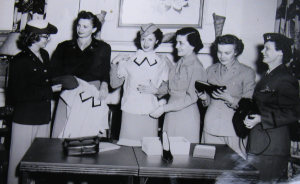
Many articles reiterate the strength, courage and discipline required of those looking to complete the flight nurse training. “Women of courage, of vision, of determination have been answering this same challenge since the dark ages until nursing has become an integral part of modern medicine,” an article titled “Girls Arrive” asserts.
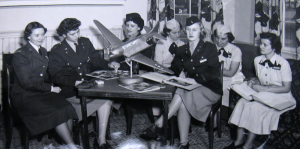
“She must be able to record each patient’s progress en route; she must have the knowledge to pick up where the last physician left off and continue till the next doctor can take over. To stumble once may cost a man his life. The rigors of jungle, mountains, desert and arctic survival are also taught with stark realism,” the article goes on to say.
Fifty nurses attended the first six-week Flight Nurse course of the Alabama Branch of the School of Aviation Medicine at Gunter AFB, thirty nine of which belonged to the Air Force. The coursework covered new and advanced medical techniques, including loading patients in and out of aircraft, aeronautical sciences, air evacuation, biophysics, dentistry, internal medicine, neuropsychiatry, physics of atmosphere, rescue and survival, surgery and more. The trainees used simulations to practice administering blood plasma to patients during flight and the art of pre-flighting oxygen masks.
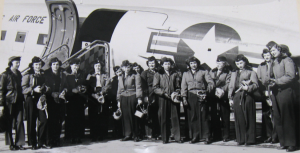
Aircraft used for medical transport in that era, such as C-47s, C-54s, C-74s and C-97s, were used in training, as well as an altitude chamber that simulated flying at 30,000 feet. The nurses traveled to Eglin AFB, Fla., to experience extreme heat and cold in the climactic chamber, and went on observation tours of Maxwell’s weather station.
It seems that the Air Force training was a hit. “Lt. Jean Elaine Thompson, Kenosha, Wis., one of the few flying nurses in the Pacific, has tried all kinds of military nursing – by ship, land and air – ‘but I’ll take the flight service every time,’” an article from the Journal New York Bureau states.
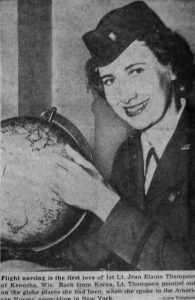
Lieutenant Thompson, 29 at the time, described how she kept such an upbeat demeanor through the trying times saying, “We keep in very high spirits because we are constantly working. And then these soldiers are much younger than those in the last war. Not much more than adolescents, some of them, right out of high school. Carefree; even if they are seriously injured, they can make a joke. They are good soldiers.”

Upon graduating, the nurses were indoctrinated with the “Alphabet of nursing,” created by Brig. Gen. Dan C. Ogle, Deputy Surgeon General, USAF. To quote this alphabet from the letter “S” and beyond, the new Flight Nurses were to always “Sooth the spirit in sickness; Treat all men with tact and understanding; Vanquish your and the patient’s fears by valiant leadership toward victory over pain; Watch and warden your charge with the eternal wisdom and wit of woman which is that unknown quantity “X” that makes the woman nurse all things to all men. You are the masters of your own souls, also of the souls of those whose strength is lost from sickness and wounds. Zest for living and the zeal to accomplish will be yours, through adherence to this alphabet.”
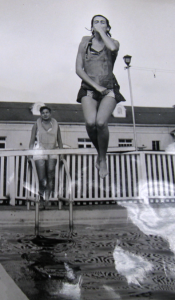
It seems that zest for living and zeal to accomplish are still requirements of being a successful Flight Nurse today, according to Maj. Rachael Palermo, Instructor of Aeromedical Evacuation at Wright Patterson Air Force Base’s United States Air Force School of Aerospace Medicine. She teaches approximately 250 nurses and medical technicians a year the basics of Aeromedical Evacuation.
The Initial Flight Nurse/Aeromedical Evacuation Technician (FN/AET) course is 22 days in length and students are presented with didactic lectures on altitude physiology, stresses of flight, in-flight nursing care considerations, patient safety, aircraft configuration, mission requirements and medical equipment. Additionally, students are challenged to apply the knowledge they gain during lectures in the facility’s realistic equipment and medical simulation scenarios. “I enjoy the chance to connect with the students in the smaller ‘crew’-focused SIMs, and they seem to appreciate the real world stories that I and my fellow cadre members share,” Palermo said.
The U.S. Air Force School of Air Evacuation recently celebrated its 75th anniversary, and these days training has ramped up to meet the technological challenges of the contemporary landscape. Flight Nurse and Aeromedical Evacuation Technician students complete 40 hours of missions on the C-130H mockup and utilize the High Bay at Wright Patterson Air Force Base, which houses two C-130 mockups as well as a C-17 mockup for training courses at USAFSAM.
We’ve come a long way from the bare-bones training grounds of the 1950s. These aircraft mockups can simulate the lighting, sounds and heating and cooling conditions that can be experienced during real life missions. The trainees now work in the simulator 50 percent of their time. The life-saving care administered aboard aircraft has ensured the safety and comfort of critical patients for nearly 75 years, and this Nurse’s Day we thank those who pioneered this role as well as those who continue to bravely serve today.

